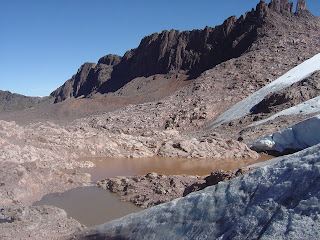The Beginning
From the moment we arrived in Peru it seemed as if we were training. Chicon, thousands of feet above Urumbamba, is known as being one of the more difficult hikes in the area. In the neighboring town, Chicon is the name of a glacier as well as the two mountains that support it. A massive, heaving monolith, we've heard stories of avalanches and of Chicon's gradual retreat up the mountain due to global warming. My host family hiked Chicon when their children were young, a 4 day affair. Ours was to take one and a half. "The Cross" Hike
From the top of "The Cross" (a mountain with a cross struck into the very top, a sign of dominance of the Spainard's Catholicism over the native religion) Chicon is resplendent- flanked by clouds, the dark terrain gradually gives way to virgin ice and snow. "The Cross" hike takes about 30 minutes and is already tiring, but we complete it diligently day after day in order to grow strong for Chicon. The Twin Towers Hike
Then came even more practice: the weekend before the hike we embarked up San Juan, the mountain of Los Dos Torres (the Twin Towers). This hike was to be about a third of the length of Chicon. After three and a half hours "the slow group" (of which I am a proud and permanent member) made it to the top. A day later my blisters and throbbing knees and quads foreshadowed the after effects of Chicon well.
Two days before Chicon most participants began to take altitude pills to deal with the vast height, although most succumbed to some sort of ailment sooner or later. The volunteers from Cusco arrived the night before and slept in the office. We gathered in the plaza in front of one of the town's two churches at 6 in the morning, tied our rented sleeping bags to our packs, and loaded ourselves, our packs, and our water into a small bus that would ferry us to the base of the mountain. A few people were using their school backpacks, but most had hard-core hiking backpacks specially fit by mountain-type people to their bodies, each one boasting more straps and danglies than the next. Mine was unique to the group: an external frame veteran of my Aunt's adventures, it came with no fancy gadgets but rather hand written tags on what I should put in each pockets as well as a poncho and a metal water bottle, which I've recently found keeps my water colder than anyone else's plastic one.
Upon reaching the base of the mountain we paid our one nuevo sol for the ride (equivalent to about 40 cents) and began to climb. Within five minutes members of the group (myself included) were out of breath. We then split into three groups, 4 boys went with the porters, who could do the 10 or so hour hike to the top in six, a few of us hung back to be in "the slow group", and the rest went into the middle group.
After clamboring through brush for about an hour a forest opened up in front of us. It looked exactly like something from Lord of the Rings, with moss curling around every bent tree and a small, talkative river winding daintily around smooth piles of rocks, but I was so intent on putting one foot in front of the other whilst still breathing that I barely noticed. I made a mental note to take pictures when we passed through on the way down, and continued.
"The Slow Group"
The Final Two Hours
The last two hours was a huge struggle, one that I barely remember. I kept my face down almost the entire time. Walk, walk, rest, rest. Walk, walk, rest, rest. First over grass and mud, then over huge hills of rocks. I felt like I was in Mordor (sorry for the continual Lord of the Rings reference). Nothing was alive, and every step had to be trod carefully lest the path you were on gave way and you tumbled to the bottom. Finally the glacier was in sight -a mound of snow jutting into the dim sky- and I experienced as odd flash of deja-vu- the glacier and its surroundings were oddly reminscent of Cleveland in the winter, when everything is shrouded by snow. I realized that I had hiked approximately 10 hours over two days to see what I saw 6 months every year of my childhood. I was vaguely disconcerted, and continued.
At the Top
We couldn't actually reach the top of the glacier, so instead we frolicked at it's base, climbing up rocks and then ice, and sliding back down again. I'll admit I expected a great deal more beauty from something so inaccessible (isn't that how it's supposed to go?) but I'm glad that I reached the top just to know that I can.
The Descent
The way down was probably my favorite... because it was less strenuous I could spend more time enjoying the surroundings . However, it was definitely more dangerous. One group member rolled and ankle and then the slope he was going down collapsed and he almost fell off the edge. Another volunteer almost slid into the river. I got a small cut on my hand, and experienced one of my more spectacular falls, sliding a couple feet on my butt and then on my knees when I tried to stand up and the weight of my backpack dragged me further. However, I did remember to take pictures of the forest on the way down, the most beautiful yet unsung part of the trek.
Ultimately, although I did expect quite a bit more from a gargantuan glacier in the Andes I'm glad that I did Chicon, for it was quite an adventure.





















